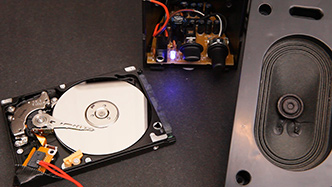It’s always fun to work on an electronic project especially when it lets you recycle old objects that are otherwise thrown into the trash. Afrotechmods is a website run by an electrical engineer nicknamed as Afroman who publishes a bunch of interesting experiments with electronics through videos. His areas of interest include power electronics, robotics, and mixed signal design.
In one of his videos, Afroman has described an interesting use of hard drive in the form of a DIY speaker. The project has been demonstrated clearly with the help of a video and doesn’t require any software installation.
Although it’s an easy and quick method to make DIY speakers after turning the drive into a speaker, it can no longer be used for storing data or any other purposes. So, it is really essential to ensure that the disk drive doesn’t contain any valuable content.
In order to build the speaker, all you need is a hard drive and some easily accessible tools like hex wrench, a multimeter, couple of thin wires, soldering iron, and an amplified audio source. Now let’s look at the extracts of the DIY project:

Building a DIY Speaker out of an Unused Hard Drive (Image Courtesy: afrotechmods.com)
To begin with, he unscrewed a hard drive with the help of a hex wrench. As soon as it was uncovered, he could see all the internal structure of the drive. Now all he needed was to make use of the parts of the drive and their functioning. The guts of the drive revealed the platter (also known as Hard Disk) which stored the data, the header which read the data, and a flex circuit attached to a flex cable. To proceed, he unscrewed the flex circuit and flipped it over while ensuring that the cable remained unharmed.
Now he used his multimeter to get a resistance of 4 Ohms to 40 Ohms between any two points on the connector. As soon as he discovered the two points, he found the connection to the drive’s voice coil. Then he soldered a pair of thin, flexible wires to the voice coils and checked the resistance again.
After that, he connected the wires to a 5 Volt power source to ensure that the heads jump. Consecutively, he attached these two wires to an amplified audio source. Notably, this source should necessarily be amplified and can’t be connected to a phone or laptop’s headphone jack. The amplifier should be an old unit that can drive actual speakers or one can also use DIY amplifiers. Now when all the connections were established, he turned up the volume and could hear the sound coming out of the drives’ voice coil.
One may wonder how a hard drive can work as a speaker but Afroman also disclosed the secret in his video. He revealed that the structure of the drive is much similar to that of a regular loudspeaker. There is a coil of wire attached to the head of the drive next to a strong magnet which functions as a speaker.
To make it clearer, he even explained the working of a loudspeaker. The movement of the drive head is initiated because it has a coil, magnet, and a head which together act as an audio source. The magnet has two poles- north and south- surrounded by a coil of wire which is next to the drive head.
When an electric current is passed through the coil, it creates a magnetic field and the south pole of the coil gets attracted to the north pole of the magnet which makes the speaker move. Similarly, as the direction of the current is changed, the two north poles repel each other thereby moving the speaker in the other direction.
This constant movement of the drive head initiated by passing the electric current eventually creates a setup which imitates the functionality of a speaker. Even though the contributor has used an old amplified audio source, one can improvise the project with other modern tools like Bluetooth speakers, for a superior quality audio.







No comments:
Post a Comment